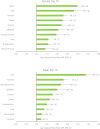Cancer and diabetes co-occurrence: A national study with 44 million person-years of follow-up
- PMID: 36441693
- PMCID: PMC9704677
- DOI: 10.1371/journal.pone.0276913
Cancer and diabetes co-occurrence: A national study with 44 million person-years of follow-up
Abstract
The number of new cases of cancer is increasing each year, and rates of diabetes mellitus are also increasing dramatically over time. It is not an unusual occurrence for an individual to have both cancer and diabetes at the same time, given they are both individually common, and that one condition can increase the risk of the other. In this manuscript, we use national-level diabetes (Virtual Diabetes Register) and cancer (New Zealand Cancer Registry) data on nearly five million individuals over 44 million person-years of follow-up to examine the occurrence of cancer amongst a national prevalent cohort of patients with diabetes. We completed this analysis separately by cancer for the 24 most commonly diagnosed cancers in Aotearoa New Zealand, and then compared the occurrence of cancer among those with diabetes to those without diabetes. We found that the rate of cancer was highest amongst those with diabetes for 21 of the 24 most common cancers diagnosed over our study period, with excess risk among those with diabetes ranging between 11% (non-Hodgkin's lymphoma) and 236% (liver cancer). The cancers with the greatest difference in incidence between those with diabetes and those without diabetes tended to be within the endocrine or gastrointestinal system, and/or had a strong relationship with obesity. However, in an absolute sense, due to the volume of breast, colorectal and lung cancers, prevention of the more modest excess cancer risk among those with diabetes (16%, 22% and 48%, respectively) would lead to a substantial overall reduction in the total burden of cancer in the population. Our findings reinforce the fact that diabetes prevention activities are also cancer prevention activities, and must therefore be prioritised and resourced in tandem.
Copyright: © 2022 Gurney et al. This is an open access article distributed under the terms of the Creative Commons Attribution License, which permits unrestricted use, distribution, and reproduction in any medium, provided the original author and source are credited.
Conflict of interest statement
The authors have declared that no competing interests exist.
Figures




Similar articles
-
Co-occurrence of cancer and diabetes in a high-income country: Age-period-cohort projections 2020-2044.Cancer Epidemiol. 2025 Feb;94:102723. doi: 10.1016/j.canep.2024.102723. Epub 2024 Dec 13. Cancer Epidemiol. 2025. PMID: 39673919
-
Equity of Cancer and Diabetes Co-Occurrence: A National Study With 44 Million Person-Years of Follow-Up.JCO Glob Oncol. 2023 May;9:e2200357. doi: 10.1200/GO.22.00357. JCO Glob Oncol. 2023. PMID: 37141560 Free PMC article.
-
Italian cancer figures, report 2013: Multiple tumours.Epidemiol Prev. 2013 Jul-Oct;37(4-5 Suppl 1):1-152. Epidemiol Prev. 2013. PMID: 24259384 English, Italian.
-
Diabetes and risk of Non-Hodgkin's lymphoma: a meta-analysis of observational studies.Diabetes Care. 2008 Dec;31(12):2391-7. doi: 10.2337/dc08-1034. Diabetes Care. 2008. PMID: 19033419 Free PMC article. Review.
-
Diabetes Mellitus as a Risk-factor for Colorectal Cancer Literature Review - Current Situation and Future Perspectives.Chirurgia (Bucur). 2018 Sept-Oct;113(5):603-610. doi: 10.21614/chirurgia.113.5.603. Chirurgia (Bucur). 2018. PMID: 30383987 Review.
Cited by
-
Repurposing metabolic regulators: antidiabetic drugs as anticancer agents.Mol Biomed. 2024 Sep 28;5(1):40. doi: 10.1186/s43556-024-00204-z. Mol Biomed. 2024. PMID: 39333445 Free PMC article. Review.
-
Does diabetes affect breast cancer survival?Cancer Rep (Hoboken). 2024 Mar;7(3):e2040. doi: 10.1002/cnr2.2040. Cancer Rep (Hoboken). 2024. PMID: 38507264 Free PMC article.
-
Risk of type 2 diabetes after breast cancer treatment: a population-based cohort study in Denmark.J Natl Cancer Inst. 2025 Mar 1;117(3):537-544. doi: 10.1093/jnci/djae261. J Natl Cancer Inst. 2025. PMID: 39436974 Free PMC article.
-
Effects of Metformin on Risk and Prognosis of Biliary Tract Cancer: A Systematic Review and Meta-Analysis.Medicina (Kaunas). 2023 Feb 6;59(2):298. doi: 10.3390/medicina59020298. Medicina (Kaunas). 2023. PMID: 36837499 Free PMC article.
-
Associations between Diabetes Mellitus and Selected Cancers.Int J Mol Sci. 2024 Jul 8;25(13):7476. doi: 10.3390/ijms25137476. Int J Mol Sci. 2024. PMID: 39000583 Free PMC article. Review.
References
-
- Sung H, Ferlay J, Siegel RL, Laversanne M, Soerjomataram I, Jemal A, et al.. Global Cancer Statistics 2020: GLOBOCAN Estimates of Incidence and Mortality Worldwide for 36 Cancers in 185 Countries. CA: A Cancer Journal for Clinicians. 2021;71(3):209–49. - PubMed
-
- Saeedi P, Petersohn I, Salpea P, Malanda B, Karuranga S, Unwin N, et al.. Global and regional diabetes prevalence estimates for 2019 and projections for 2030 and 2045: Results from the International Diabetes Federation Diabetes Atlas, 9th edition. Diabetes research and clinical practice. 2019;157:107843. doi: 10.1016/j.diabres.2019.107843 - DOI - PubMed
-
- Ministry of Health. Living Well with Diabetes: A plan for people at high risk of or living with diabetes 2015–2020. Wellington: Ministry of Health; 2015.
Publication types
MeSH terms
Substances
LinkOut - more resources
Full Text Sources
Medical

